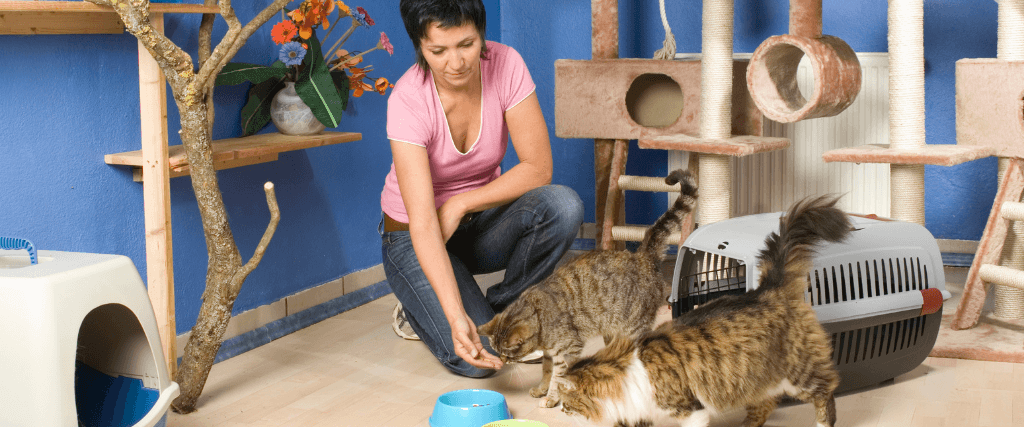While the aloof, independent nature of cats can make them prefer solitude, they are social creatures. They may prefer to hunt alone, but at other times, they enjoy the company of other members of their species. In feral groups, felines tend to form complex social groups in which they play, groom one another, and simply enjoy each other’s company.
That doesn’t mean, though, that maintaining harmony in a multi-cat household is easy. Though your cat might enjoy having a furry sibling, remember that your feline friend has unique territorial needs. To keep the peace, it is essential to ensure that every cat’s needs are met.
As veterinarians, we have had countless cat owners come to us at their wits’ end due to behavioral issues in their multi-cat homes. From fighting and aggression to eliminating outside the litter box, a lot of problems can arise when there is more than one cat in the home. The good news, though, is that many of these issues can be corrected by being mindful of your cat’s needs and making a few simple changes. Keep reading to discover some simple tips and tricks for navigating your multi-cat household.
Provide Plenty of Resources
If aggression or guarding behaviors are plaguing your multi-cat home, you may not be providing enough resources. While you might think that you have plenty of litter boxes and there is more than enough food and water to go around, your cats may see things a bit differently. This issue could also cause litter box aversion.
Provide at least one litter box for every cat in your home, plus an extra. Some cats refuse to share litter boxes with others, so this simple change could eliminate (pardon the pun!) many problems. Make sure you have more than one food and water station, too. This is especially important if you have noticed any of your cats “guarding” their food and water and keeping your other feline family members away.
Cats should have several scratching surfaces, too. Try to provide both horizontal and vertical surfaces as well as posts made from different materials to suit all your cats’ needs and preferences. Make sure your feline friends have plenty of spaces to hide and plenty of toys to choose from.
Maximize Vertical Space
Even if you live in a small home, you can give your cats a lot of space to roam and explore by taking advantage of vertical space. Cats love climbing, and many feel more secure when they can survey their surroundings from high lookout points. Thankfully, maximizing the vertical space in your home is easy!
Some of the ways you can maximize the vertical space in your home are as follows:
- Allow them to access high places like the top of your fridge or the space between your cabinets and the ceiling
- Install perches, ladders, or set up a cat tree (or several!)—there are plenty of commercially made products to choose from, or you can get creative and build your own
- Have at least one perch for every cat in your home
- Include perches or other opportunities to get up high near windows, so your kitties can keep a watchful eye on the world outside
Make Exercise a Priority
Many house cats are not nearly as active as they should be. And in addition to causing weight gain, lack of activity can cause pent-up energy that bursts out in the form of aggression. Make interactive play sessions with all your cats a part of your daily routine. Regular playtime is great for your cats’ physical health, and it will help keep them from becoming furry balls of pent-up energy. Plus, playing together could help your cats bond and form stronger relationships with one another.
Make sure you have plenty of toys for your cats to play with while you are away, too. Automated toys are great, and they can help your feline friends stay active when you are at work. Invest in a few different options, and switch them out every so often to keep your cats interested.
Rule Out Health Problems
If things have been going smoothly in your multi-cat home and you suddenly start experiencing aggression between cats, litter box aversion, or other issues, a trip to the vet’s office is in order. Cats have mastered the art of hiding signs of illness, but changes in behavior are a telltale sign that something is amiss. Just like pain or discomfort might make you feel a bit grumpy, it can cause irritability and aggression in cats. A cat who stops using their litter box could be in pain, too.
Cats All She Wrote
Maintaining peace and harmony in a multi-cat home is often tricky, but it can be done. Remember, though, that some cats simply do not enjoy the company of other felines. If your cat is particularly independent, you might want to reconsider adding another furry family member. By providing more than enough food and water stations, litter boxes, toys, and vertical space, it’s usually easy to keep problems at bay and maintain a comfortable home for yourself and your furry family members.
If you share your home with a few feline friends and are having trouble keeping everyone happy, we are here to help. As veterinarians, we can assess your cats’ health and behavior and make recommendations based on their individual needs. Contact us today for the care your feline friends need.

